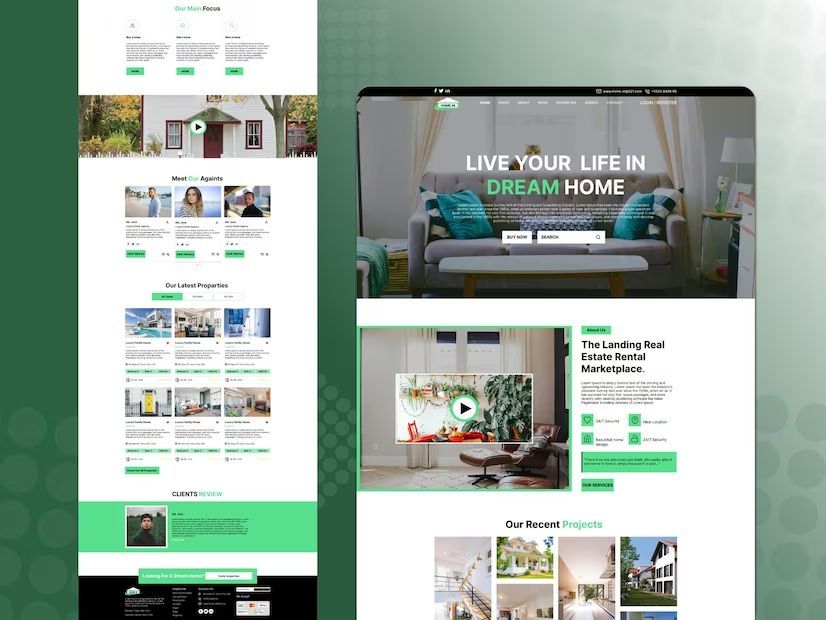BLOG
A/B Testing for Landing Pages: Best Practices

In the fiercely competitive landscape of digital marketing, every click counts. Landing pages serve as crucial touchpoints in the conversion journey, where visitors transition from mere browsers to engaged customers. However, crafting landing pages that effectively drive conversions isn't a one-size-fits-all endeavor.
This is where A/B testing steps in as a game-changer. A/B testing, also known as split testing, empowers marketers to compare different versions of their landing pages to determine which resonates best with their audience. It's a data-driven approach that allows for iterative improvements based on real user behavior and preferences.
But executing A/B tests for landing pages isn't just about throwing random elements together—it requires a strategic approach grounded in best practices. In this guide, we'll delve into the nuances of A/B testing for landing pages, exploring key strategies, pitfalls to avoid, and proven tactics to maximize conversion rates and optimize user experience.
Understanding the Basics of A/B Testing
A fundamental grasp of A/B testing is essential for marketers aiming to optimize their landing pages. Essentially, A/B testing involves comparing two versions of a webpage—A and B—by exposing them to similar audience segments and analyzing which version performs better in achieving predefined goals.
It's about systematically testing changes, whether subtle or significant, to determine their impact on user behavior and conversion rates. Marketers need to understand not just the mechanics of how A/B testing works but also its broader significance in refining user experience and driving desired actions.
With a solid foundation in A/B testing principles, marketers can navigate the intricacies of experimentation with confidence, ultimately leading to more effective landing pages and higher conversion rates.
Defining Clear Testing Objectives
Before diving into A/B testing, it's imperative to establish clear and measurable objectives. These objectives serve as the compass guiding the entire testing process, ensuring that every variation tested aligns with overarching business goals.
Whether the objective is to increase click-through rates, boost sign-ups, or enhance engagement metrics, clarity is key. Marketers should articulate specific, achievable goals that are tied to actionable insights.
Without well-defined objectives, A/B testing can devolve into aimless experimentation, yielding inconclusive results and wasted resources. By defining clear testing objectives from the outset, marketers set the stage for focused experimentation that drives meaningful improvements to landing page performance.
Identifying Key Performance Metrics
In the realm of A/B testing, metrics reign supreme. Identifying the right key performance indicators (KPIs) is essential for accurately gauging the effectiveness of different variations. These metrics could include conversion rate, bounce rate, average session duration, or any other data point relevant to the goals of the test.
By aligning chosen metrics with testing objectives, marketers ensure that their analysis provides actionable insights into user behavior and preferences. However, it's crucial to strike a balance between focusing on too few metrics, which may provide a limited view of performance, and overwhelming oneself with an excess of data, leading to analysis paralysis.
Selecting the most pertinent KPIs allows marketers to derive clear, actionable insights from their A/B tests, driving iterative improvements to landing page effectiveness.
Crafting Hypotheses for Testing
Crafting hypotheses for testing is a crucial step in the A/B testing process, as it lays the groundwork for structured experimentation and meaningful analysis. By formulating hypotheses, marketers can make educated guesses about how changes to a landing page will impact user behavior and conversion rates.
These hypotheses provide direction and focus to the testing process, guiding the selection of variables to manipulate and the expected outcomes to measure.
- Importance of Hypotheses: Understand why hypotheses are essential for guiding A/B testing experiments.
- Formulating Hypotheses: Learn how to craft hypotheses that are specific, measurable, and actionable.
- Testing Variables: Explore different variables that can be manipulated in A/B testing experiments.
- Predicting Outcomes: Consider how hypotheses can help predict the potential impact of changes on user behavior.
- Refining Strategies: Discover how hypotheses can inform iterative improvements to landing page performance.
Crafting hypotheses for testing empowers marketers to approach A/B testing with clarity and purpose, enabling them to derive meaningful insights that drive continuous optimization of landing page effectiveness. By formulating hypotheses that are grounded in data and aligned with testing objectives, marketers can unlock the full potential of their A/B testing efforts, ultimately leading to higher conversion rates and improved user experiences.
Selecting Variations to Test
With hypotheses in hand, the next step is to determine the variations to test. This involves identifying specific elements of the landing page—such as headlines, calls-to-action, imagery, or layout—that could influence user behavior.
Variations should be carefully chosen based on the insights gleaned from market research, user feedback, and best practices in web design. It's important to strike a balance between making meaningful changes that have the potential to drive significant improvements and minimizing risk by testing one variable at a time.
By selecting variations thoughtfully, marketers can isolate the impact of individual elements and gain valuable insights into which aspects of the landing page resonate most with their audience.
Implementing A/B Testing Tools
Effective A/B testing requires robust tools that facilitate experimentation and data analysis. Fortunately, a plethora of A/B testing tools are available, ranging from simple, user-friendly platforms to more advanced solutions with sophisticated features.
When selecting a tool, marketers should consider factors such as ease of use, integration capabilities with existing systems, scalability, and reporting functionalities. Implementing the right A/B testing tool streamlines the testing process, allowing marketers to efficiently deploy experiments, monitor performance in real-time, and derive actionable insights from test results.
With the right tools at their disposal, marketers can elevate their A/B testing efforts and make data-driven decisions that propel landing page optimization forward.
Running Controlled Experiments
Once variations are selected and testing tools are in place, it's time to execute controlled experiments. This involves dividing the audience into distinct groups and exposing each group to a different version of the landing page.
It's crucial to maintain control over external factors that could influence outcomes, such as changes in traffic sources or seasonality trends. Additionally, experiments should be run for a sufficient duration to capture meaningful data and account for potential fluctuations in user behavior over time.
By conducting controlled experiments with rigor and consistency, marketers can ensure the reliability and validity of their test results, enabling them to draw accurate conclusions about the effectiveness of different page variations.
Analyzing Test Results Effectively
Analyzing test results effectively is crucial for deriving actionable insights and driving meaningful improvements in landing page performance. Here's how to do it:
- Dive into the data: Delve deep into the metrics collected during the testing period.
- Compare performance: Analyze how different variations performed in terms of key metrics.
- Identify patterns: Look for trends or correlations that emerge across variations.
- Understand user behavior: Gain insights into why certain variations resonated more with users.
- Utilize visualizations: Visualize data using graphs, charts, and heatmaps for better understanding.
By thoroughly analyzing test results, marketers can uncover valuable insights that inform future iterations of landing pages and drive continuous improvement in conversion rates and user experience.
Iterating and Scaling Successful Tests
A/B testing is not a one-and-done endeavor; it's an iterative process of continual refinement and optimization. Armed with insights from previous tests, marketers can iterate on successful variations, further tweaking and fine-tuning elements to maximize their impact.
Moreover, successful tests can serve as blueprints for scaling improvements across other pages or campaigns within the marketing ecosystem. By applying lessons learned from successful tests to broader initiatives, marketers can amplify their impact and drive consistent improvements in overall conversion rates and user engagement.
Avoiding Common Pitfalls in A/B Testing
Avoiding Common Pitfalls in A/B Testing is crucial for ensuring the accuracy and effectiveness of your experimentation process. While A/B testing offers immense potential for optimizing landing pages, there are pitfalls that can undermine your efforts. Here's a quick guide to navigating these pitfalls successfully:
- Testing Too Many Variations Simultaneously: Avoid the temptation to test multiple changes at once, as it can make it difficult to pinpoint which alteration had the desired effect.
- Improper Audience Segmentation: Ensure that your audience segments are well-defined and distinct, preventing skewed results that may arise from mixing diverse demographics.
- Drawing Conclusions Based on Insufficient Data: Gather enough data before drawing conclusions to ensure statistical significance and reliability in your findings.
- Confirmation Bias: Stay vigilant against confirmation bias by remaining open to unexpected insights and allowing the data to guide your decisions objectively.
- Lack of Continuous Monitoring and Iteration: A/B testing is an iterative process; failing to continuously monitor and iterate based on results can lead to missed optimization opportunities.
By steering clear of these common pitfalls, you can maximize the effectiveness of your A/B testing efforts, drive meaningful improvements in landing page performance, and achieve your conversion goals with confidence.
Mastering the art of A/B testing is pivotal for marketers striving to enhance the effectiveness of their landing pages and drive higher conversion rates. By understanding the basics of A/B testing, defining clear objectives, identifying key performance metrics, crafting hypotheses, selecting variations thoughtfully, implementing robust testing tools, running controlled experiments, analyzing results effectively, iterating on successful tests, and avoiding common pitfalls, marketers can unlock the full potential of their landing pages.
As you embark on your A/B testing journey, remember that it's not just about making changes—it's about making informed decisions backed by data and insights. With the right strategies and methodologies in place, you can optimize your landing pages to outperform the competition and achieve your business objectives. Contact Social Cali today at 1-415-888-9561 or sales@socialcali.com to discover how our proven social media marketing strategies can help you dominate your market.
Experience firsthand how Social Cali can empower your business to thrive while saving you valuable time and resources. Join the ranks of satisfied clients who have witnessed the transformative impact of partnering with us. Let's elevate your digital marketing efforts together and propel your business to new heights of success.











